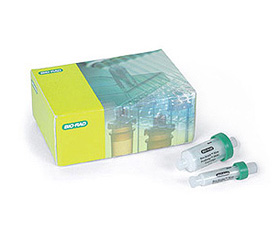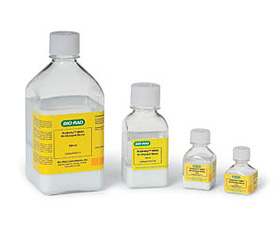Nickel Columns for Chromatography
Nickel columns are used for immobilized metal affinity chromatography (IMAC) for the purification of recombinant proteins with a polyhistidine tag on either terminus. The most common tag is a hexahistidine tag (6xHis tag or His6 tag). Vectors with longer or shorter histidine tags are also used, and some recombinant proteins have tandem 6xHis tags.
A nickel column is the most common column type used for IMAC, although cobalt, copper and zinc are also used to charge the column. Generally nickel resin gives the highest yield. A recombinant protein with a 6xHis tag has a high affinity for nickel, whereas most other proteins will either bind with low affinity, or not at all.
Nonspecific binding due to electrostatic attraction to the nickel beads can be minimized by addition of NaCl to the load buffer. After application of the sample, using a wash buffer with a low concentration of imidazole elutes any proteins that are weakly bound to the nickel column. Additionally, low concentrations of a nonionic detergent or glycerol can reduce hydrophobic interactions.

Fig. 1. Tris-NTA technology: comparison of mono-NTA and tris-NTA surfaces. The mono-NTA or tris-NTA groups are activated by nickel (II) to form Ni-NTA or 3 x Ni-NTA complexes, respectively. These complexes are able to capture polyhistidine-tagged proteins. A, the mono-NTA surface is the traditional approach for capturing histidine-tagged proteins but it achieves weak binding and results in ligand decay, baseline drift, distorted kinetic results, and inaccurate fitting to kinetic models; B, the ProteOn™ trivalent tris-NTA (3x NTA) surface improves binding stability and increases binding selectivity to histidine-tagged proteins. Ni-NTA ( orange ) binding to histidine ( grey ) occurs after activation with nickel(II). C, structure of surface bound mono-NTA molecule (left) and tris-NTA molecule (right). Each individual NTA group is circled.
Recombinant protein is usually eluted from an Ni column with a high concentration of imidazole. Other elution methods include lowering pH, so that the histidines become protonated and no longer have affinity for the nickel resin, or using strong chelating agents such as EDTA and EGTA. The use of a strong chelating agent results in the nickel being stripped from the column and the elution of protein-nickel complexes.
An advantage of using an IMAC column for recombinant protein purification is that the nickel-histidine reaction is not dependent on secondary structure. Therefore a nickel column can be used for purification of denatured protein. A further potential benefit of using a nickel column is that a protein can be renatured while still bound to the nickel resin. Elution with imidazole retains the renatured state.
Nickel Resin and Nickel Beads
There are two methods for producing immobilized nickel resins. Both methods use a chelator to form a coordination compound with metal ions. The two most common chelators are iminodiacetic acid (nickel-IDA or Ni-IDA) and nitrilotriacetic acid (nickel-NTA or Ni-NTA). Both Ni-IDA resin and Ni-NTA resin have higher binding capacities for histidine than other resins with cobalt or other divalent or trivalent cations.
Bio-Rad offers a number of products that use IMAC technology. For purification of 6xHis-tagged proteins, there are both precharged nickel resin (for bulk purification protocols and packing into your own columns) or prepacked, ready-to-use IMAC cartridges. Nickel beads can be used in low- and medium-pressure chromatography systems or in gravity flow and spin columns.
Bio-Rad's Nickel-Charged Columns, Resins, and Sensor Chips
In addition to nickel column chromatography, nickel-NTA can also be used to capture histidine-tagged proteins on a surface for surface plasmon resonance (SPR) analysis. For example, protein-protein interaction parameters can be determined using a nickel-NTA–coated sensor chip to immobilize a histidine-tagged target protein followed by the introduction of untagged protein that interacts with the tagged protein. These sensor chips can be used to characterize the kinetics of protein complex formation as well as for the purification and identification of the interacting proteins and other complex components.
Bio-Rad's innovative tris-NTA technology provides superior immobilization of histidine-tagged proteins on the surface of sensor chips used with SPR biosensors. Strong and selective histidine-tagged protein capture ensures a stable baseline and accurate kinetic analyses. This modified nickel-NTA technology increases both the affinity of the chip for 6xHis-tagged proteins and permits the control of protein orientation.



